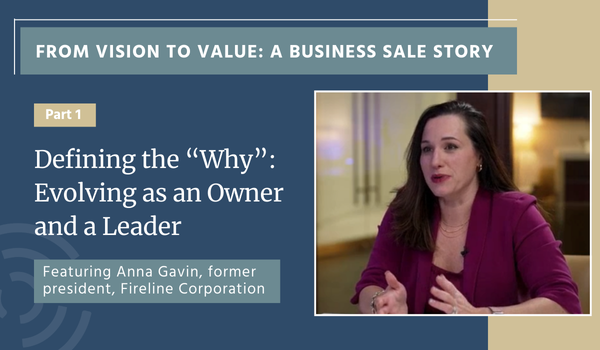What distinguishes thriving government contractors from those that languish? It’s often a matter of mindset. That’s the topic CCA Managing Director Marty O’Neill and Shirley Collier, President of Scale 2 Market, discussed on the Growth Masters Federal podcast, which this blog recaps.
Investors are still active in the M&A middle market, even in a difficult economy. Strategic investors are responding to delayed contract awards and a tight labor market by targeting just the right bolt-on acquisitions. And private equity (PE) groups still have a great deal of dry powder to deploy, leading them in search of quality companies.
The challenge for lower and middle market government contractors is how to capture their share of this market interest. It starts with understanding the thought processes that build value and accelerate growth.
There are multiple paths to growing a government contracting business, and each is influenced by the founders’ thinking patterns. A look at two very different contractors (each a composite of real companies) demonstrates how these patterns can fuel or thwart success and underscores the striking difference in results for growth-minded businesses vs those with a limiting mindset.
A Snapshot of Two Contractors
Grow-Right Company started as a niche software development business, led by one founder who came out of that industry. The business operated stably for a few years, then revenue stagnated at $20 million and earnings peaked at 10%. Recently, those figures began drifting downward.
Limiting Company is a 10-year-old cybersecurity business founded by two engineers who worked in the intelligence community. They started off securing contracts with their previous employer and spent upwards of 60 hours per week on billable work. Their goal was to grow the business from its current size of $8 million to $32 million before selling to a larger company.
The founders of these government contractors applied very different thinking to running and growing their businesses, achieving markedly different results.
Failing to Plan is Planning to Fail
At first, Grow-Right Company did not engage in the planning needed to grow the business. Recognizing the company was falling short of its vision of making a real dent in the marketplace and improving employees’ lives, the founder took decisive steps.
She hired a consultant to conduct market research to identify the demand for her products and services in the federal marketplace, then developed a clear company vision, articulated a unique value proposition, and identified critical success factors. With this foundation in place, she developed measurable business goals, strategies to support them, and an action plan that emphasized building a systemic, disciplined business development culture. The founder also secured staff buy-in on the new plan, held the team more accountable, provided incentives for achieving profitable growth initiatives, and revisited the plan often to keep it agile. The founder envisioned building enterprise value to $40M in three years.
The founders of Limiting Company did not prioritize planning and instead focused on delivering services and keeping customers happy, leaving them too busy with client work and supervisory responsibilities to think about how to grow the business. They confused activity with progress and inadvertently created a “hero mentality,” where the founders and a few other employees always swooped in at the last minute to resolve a bad situation.
This decision proved costly in several ways: The founders and other “heroes” began to resent that role and the pressure it created. The other employees didn’t feel accountable, so they waited for the heroes to act. And the company failed to develop the depth of leadership to run a thriving business.
Because the Limiting Company founders did not engage in active, purposeful planning, they did not have a shared vision and philosophy. And because they were not in sync, they struggled to agree on vital decisions about key issues like building out the leadership team, focusing valuable business development resources, investing in scalable operational processes, and layering new technology onto their existing systems.
The Successful Thinking of Grow-Right Company
Through her strategic, market-driven planning, the Grow-Right Company founder realized she might not have the right leadership team to move beyond the current state of steady revenues and achieve more aggressive goals. So she made a bold move, creating a new organizational structure and asking the top six leaders to reapply for the new roles.
Two former leaders agreed to step back from their roles and two employees were promoted to the management team. Now the company had the right skillsets at the top, the management team was reinvigorated, and employees had greater confidence in leadership.
The founder also made focused, data-driven business development a higher priority. Through her research, she learned that when government contractors struggle to grow, it is often for reasons like these:
- They do not understand the complex, highly regulated federal marketplace.
- They do not know how to develop new business or structure a disciplined business development function.
- They lack clarity on what sets them apart from competitors.
- They are led by professionals with a technical background, who find it difficult to maintain the right balance between business development and client work and to transition into a true CEO role.
Recognizing that Grow-Right Company suffered from some of those challenges, the founder adopted a purposeful, disciplined approach to business development. With the help of an advisor, she developed a two-year strategic business development playbook—mapping out the target agencies, opportunities, contract vehicles, teaming partners, messaging, processes, roles and responsibilities, milestones, revenue and profit goals, and compensation incentives that were vital to a thriving business.
The founder also recognized that success demanded an intentional focus on the organization’s mind, body, and soul. The company set up the right leadership team (the mind), invested in value-generating systems and processes (the body), and created a culture (the soul) that attracted and retained top talent. What made the business’s recruitment so successful was its intentional approach to researching the candidate market, articulating its employer brand, seeking candidates that shared its vision, and using assessment tools to screen candidates and position them for success.
The results were significant: Grow-Right Company achieved a compound annual growth rate (CAGR) of 26% over three years, reaching the target enterprise value of $40M. The founder maintains a healthy balance between her work and personal life and is confident that the company’s value is on solid ground.
The Not-so-Successful Thinking of Limiting Company
Unfortunately, Limiting Company’s thought processes hindered its growth tremendously.
Rather than hire business development staff (which the more frugal of the founders resisted), they took the more conservative approach of assigning one of the founders to focus on this essential function. But even as she developed relationships with new clients, her co-founders expected her to continue doing client work—and that simply pushed her back into the old role.
Unlike growth-minded contractors, the founders of Limited Company also did not prioritize the thinking, people, systems, and processes required to succeed in the government contracting market. Instead, they made many poor decisions that thwarted their success:
- They insisted on pursuing only prime contracts, limiting their opportunities and their exposure to government agencies across the broader marketplace.
- They were not willing to explore new product and service offerings.
- They did not embrace teaming with partners.
- They did not take the time to research and understand the demand for their services.
- They were unwilling to invest in building the right leadership team to scale the business.
- They failed to develop repeatable, market-driven processes that would enable consistent new business wins.
The financial results were not catastrophic, but they clearly represent a missed opportunity. Instead of achieving the goal of growing to $32M in revenue, Limiting Company only reached $10M in revenue with an EBITDA of 8%. Worse, the employees became frustrated, customer service suffered, and the founders started to feel trapped in the very business they created.
As the starkly different experiences of these two companies illustrate, thinking patterns have the power to fuel a government contractor’s success or derail its growth journey. Through a deliberate and intentional growth mindset and a focus on data-driven, market-informed planning, government contractors can lay the foundation to achieve aggressive growth goals and create greater business value in the complex, highly regulated, but opportunity-rich federal marketplace.
About Chesapeake Corporate Advisors
Chesapeake Corporate Advisors is a boutique investment banking and corporate advisory firm providing strategic advisory services (value creation) and investment banking services (value realization) to companies with revenues between $10 million and $200 million. For more information, visit www.ccabalt.com or call 410.537.5988.





